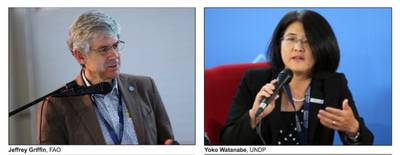Feeding the planet and protecting biodiversity: Can we choose both outcomes?
The objective of this session was to discuss how agriculture and environmental policies and practices can better support each other towards biodiversity-positive outcomes, while ensuring food and nutrition security.

Agriculture is intrinsically linked to biodiversity. Farmers, herders and other agricultural households have been instrumental in transforming the world. They have created and maintained biodiverse landscapes in many parts of the world. They have also bred and maintained a diversity of animals and plants crucial for human nutrition and food security. At the same time, however, traditional agriculture has become less sustainable in the face of population increase, climate change, and other drivers.
Since the second half of last century, the progressive adoption of intensive agriculture, where most aspects of production are driven by technological and agro-chemical interventions, has resulted in important productivity gains. This has, as a result, slowed the expansion of cropland into natural areas, including forests. There have been, however, significant unintended negative environmental consequences of intensive agriculture. Chief among these are the degradation and loss of biodiversity – both in terms of crop genetic diversity, farm-level biodiversity and at the level of the ecosystems.

In many countries, national agriculture priorities and investments focus almost exclusively on increasing production with limited regard for environmental (and therefore biodiversity) tradeoffs. At the same time, national environmental priorities struggle to address agricultural and food security concerns although they are clearly the two faces of the same coin.
The 2030 Agenda for sustainable development calls for much more effective integration between sectors, goals and stakeholder activities, acknowledging the need for policy dialogues that address trade-offs and craft workable solutions. Governments, civil society, consumers and the private sector, including the farmers, together can work out mechanisms that lead to the adoption of ‘biodiversity-friendly’ practices. This requires harmonized policies and strategies, investment and incentive mechanisms that promote such practices and catalyze environment and agriculture working in synergy, leading to overall better biodiversity and agriculture outcomes.
Moderator: Jeff Griffin (Senior Coordinator GEF Unit, FAO)
Panellist:
- Lusike Wasilwa (Director - Crop Systems, Kenya Agriculture and Livestock Research Organization - KALRO)
- Edda Fernandez Luiselli (Chief of Staff for the Under Minister of Environmental Promotion and Regulation, Ministry of Environment and Natural Resources, Mexico)
- Mark Zimsky (Senior Biodiversity Specialist, Global Environmental Facility - GEF)
- Yoko Watanabe (Global Manager of GEF Small Grants Programme, UNDP)
- Marieta Sakalian (Senior Programme Manager, UNEP)
Panel discussion
Discussions during this panel session covered perspectives to craft a common agricultural and environmental agenda, and share successful approaches for mainstreaming biodiversity into agriculture.
Mexico shared several examples of the use of different incentives (tourism adaptation, taxes, certification), and developing coalitions with other countries had supported links between agriculture and environment to preserve genetic biodiversity.
Other approaches shared highlighted the need for a change in priority setting and development of different landscaping approaches (KALRO). The importance of these landscape and partnership approaches to mainstream biodiversity into agriculture were emphasized (UNDP), together with the need for stronger laws to protect agro-ecological approaches. A need for appropriate policy and institutional frameworks to support this mainstreaming was identified (UNEP), including identification of best practices. It is likely that individual project results will likely have small scale impact as to address the agriculture and biodiversity interface, programming should be targeted (GEF).
